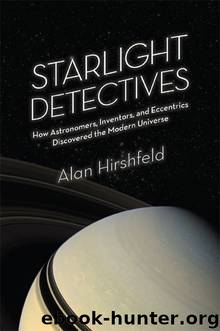Starlight Detectives by Alan Hirshfeld

Author:Alan Hirshfeld [Hirshfeld, Alan]
Language: eng
Format: epub
ISBN: 9781934137796
Publisher: Bellevue Literary Press
While astronomers were engaged in the Dopplerian debate over star colors, a little-known conjecture wafted in the background. In December 1848, French physicist Armand-Hippolyte-Louis Fizeau delivered a lecture at the Société Philomatique in Paris. (Fizeau and his collaborator Léon Foucault had taken the first successful daguerreotype of the Sun in 1845.) Unaware of Christian Doppler’s prior work, Fizeau laid out the same mathematical formulations now identified with the name of his colleague in Prague. But Fizeau’s astronomical assertions were rooted in hard observational facts. Instead of addressing the influence of motion on the overall colors of stars, Fizeau focused on the spectroscopic ramifications. Even at a small fraction of Doppler’s breakneck stellar velocities, he found the Fraunhofer lines would be measurably shifted either redward or blueward, depending on the star’s direction of motion. Significantly, the lines would retain intact, their diminishment of light merely displaced to a different wavelength. Measurement of the shift of a spectral line from its laboratory-standard wavelength allowed the computation of a star’s radial velocity in space.
Since antiquity, astronomers have kept track of the positions of stars, both to provide a reference grid against which to measure the movements of planets and comets, and to track the movements of the stars themselves. These minuscule translations are seen in two dimensions, projected onto the plane of the night sky. If the distance to a star is known, its gradual creep through a constellation can be mathematically converted into actual velocity units, such as miles or kilometers per second. With Fizeau’s proposal, the spectroscope promised to reveal a star’s velocity in the third dimension, radially toward or away from Earth. Combining a star’s planar and radial movements renders its full, three-dimensional motion through outer space. In sufficient number, stellar velocities are key to probing the dynamics of our galaxy. The measurement of radial velocities was one part of the new astrophysics with the potential to arouse the interest of classical astronomers.
Given their eventual impact on astronomy, it might seem incredible that Doppler’s and Fizeau’s findings were not more widely disseminated upon their release; technical journals did exist, but scientific exchange across disciplines and across national borders still relied heavily upon personal correspondence and word of mouth. (Fizeau’s paper was not published until 1870.) It was not until the late 1850s that the famed Scottish mathematician James Clerk Maxwell encountered the Doppler–Fizeau effect in a retrospective volume on optical research. Maxwell had an abiding interest in the phenomenon of color, publishing a series of papers on the subject and conducting the first public demonstration of color photography at London’s Royal Institution in 1861. (Maxwell obtained three black-and-white photographs of a tartan ribbon taken, respectively, through red, green, and blue filters, then projected the images through these filters onto a screen, where the magnified ribbon appeared in its true coloration.)
Maxwell was present in the audience on May 26, 1864, when William Huggins and William Allen Miller presented their paper, “On the Spectra of Some of the Fixed Stars,” before the Royal Society.
Download
This site does not store any files on its server. We only index and link to content provided by other sites. Please contact the content providers to delete copyright contents if any and email us, we'll remove relevant links or contents immediately.
| Aeronautics & Astronautics | Astronomy |
| Astrophysics & Space Science | Comets, Meteors & Asteroids |
| Cosmology | Mars |
| Solar System | Star-Gazing |
| Telescopes | UFOs |
Tools of Titans by Timothy Ferriss(8215)
Turbulence by E. J. Noyes(7935)
Secrets of Antigravity Propulsion: Tesla, UFOs, and Classified Aerospace Technology by Ph.D. Paul A. Laviolette(5309)
Astrophysics for People in a Hurry by Neil DeGrasse Tyson(5130)
Room 212 by Kate Stewart(5035)
Design of Trajectory Optimization Approach for Space Maneuver Vehicle Skip Entry Problems by Runqi Chai & Al Savvaris & Antonios Tsourdos & Senchun Chai(5011)
Pale Blue Dot by Carl Sagan(4907)
The David Icke Guide to the Global Conspiracy (and how to end it) by David Icke(4624)
A Journey Through Divination and Astronomy by Publishing Pottermore(4341)
Goodbye Paradise(3724)
Apollo 8 by Jeffrey Kluger(3635)
COSMOS by Carl Sagan(3553)
Losing the Nobel Prize by Brian Keating(3498)
The Five People You Meet in Heaven by Mitch Albom(3474)
How to Read Water: Clues and Patterns from Puddles to the Sea (Natural Navigation) by Tristan Gooley(3406)
Brief Answers to the Big Questions by Stephen Hawking(3369)
How to Read Nature by Tristan Gooley(3249)
The Order of Time by Carlo Rovelli(3144)
A Brief History of Time by Stephen Hawking(2959)
